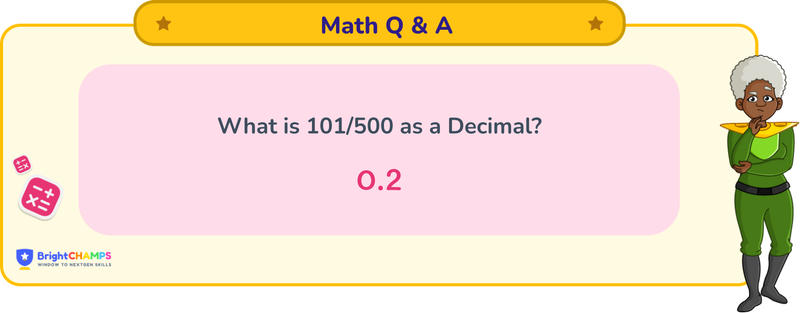Summarize this article:
 249 Learners
249 LearnersLast updated on August 5, 2025
101/500 as a Decimal

It is a simple question on decimal conversion. Firstly, we have to learn fractions and decimals. A fraction represents a part of the whole. It has two parts, numerator (number on the top) here, 101 represents how many parts out of the whole. The denominator (number below) shows how many parts make the whole, here it is 500. A decimal is a way to represent a number that is not whole, using a (.) or a decimal point to separate the whole part from the fractional part. The numbers to the left of the decimal point represent the whole, and those to the right represent the fractional part.

What is 101/500 as a decimal?

Answer
101/500 in decimals can be written as 0.202. It is a terminating decimal, which means it does not repeat infinitely.
Explanation
To get 101/500 in decimal, we will use the division method. Let's see the step-by-step breakdown of the process:
Step 1: Identify the numerator and denominator because the numerator (101) will be taken as the dividend, and the denominator (500) will be taken as the divisor.
Step 2: Since 101 is smaller than 500, it can't be divided directly, so we will take the help of decimals. We will add 0 to the dividend by considering it as 101.0 and add a decimal point in the quotient place.
Step 3: Now we consider 1010, which we can divide by 500.
Step 4: 500 goes into 1010 twice (500 × 2 = 1000). We will write 2 in the quotient place and subtract 1000 from 1010, giving us 10.
Step 5: Bring down another 0 to make it 100. Repeat the division process. Since 500 cannot go into 100, we add a 0 in the quotient.
Step 6: Bring down another 0 to make it 1000. 500 goes into 1000 twice (500 × 2 = 1000), and we subtract 1000 from 1000 to get a remainder of 0. The division process ends here as the remainder is 0, making it a terminating decimal.
The answer for 101/500 as a decimal will be 0.202.

Important Glossaries for 101/500 as a decimal
- Fraction: A numerical quantity that is not a whole number, representing a part of a whole.
- Decimal: A number that uses the base ten and includes a decimal point to separate the whole part from the fractional part.
- Numerator: The top part of a fraction, indicating how many parts of the whole are being considered.
- Denominator: The bottom part of a fraction, showing how many parts make up a whole.
- Terminating Decimal: A decimal that ends and does not repeat infinitely.




